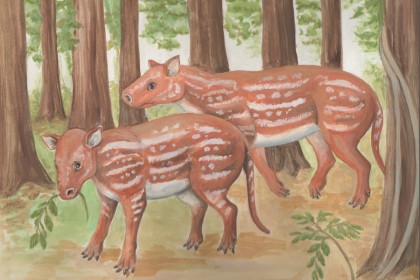Some newly discovered fossils of the horse, the rhino and the tapir led researchers to solve age-old riddles concerning the common ancestor for the these animals. More than that the fossils reiterate the contention that India, ancient Gondwana island, was once separated from the mainland.
The animals group likely to have originated on the subcontinent when it was still an island that swiftly for collision with Asia, the researchers said in their report published in the online journal Nature Communications.
Scientists from Johns Hopkins University, after combing paleontological debris in Wyoming moved to India in 2001 and found in an open-pit coal mine near Mumbai a mother-of-all 200 Cambatherium thewissi fossils.
These ancient animals, called Perissodactyla, lived 56 million years ago and the “odd-toed” ungulate belonged to this group with odd-numbered toes on their rear feet. Though the fossil record was rather thin, it helped researchers crack the so-called “missing-link” in evolution of these animals.
The Cambaytherium was considered the youngest Perissodactylia ever discovered and believed to be the missing link between older and younger animals and the new fossils connect both biological and geographical evolution.
Professor of evolution and functional anatomy at Johns Hopkins, Ken Rose, said that Cambaytherium traits indicate that at the time the animal was alive, India was isolated without land link to Africa or the Arabian peninsula.
Rose and his team were able to piece together what Cambaytherium might have looked like. It could have weighed between 45 pounds and 75 pounds, resembling a mini-version of both a horse and a rhino, though without the hallmark on its hooves.
gondwanaRose and his team were funded by the National Geographic Society to send a research team to the mine site in Gujarat for two weeks at a time once every year or two over the past decade.
The mine yielded them a treasure trove of teeth and bones amounting to 200 fossils of little known Cambaytherium thewissi, dated back to 54.5 million years, making them slightly younger than the oldest known Perissodactyla remains. But, Rose inisists that the findings provide a window into what a common ancestor of all Perissodactyla would have looked like.
“Many of Cambaytherium’s features, like the teeth, the number of sacral vertebrae, and the bones of the hands and feet, are intermediate between Perissodactyla and more primitive animals,” Rose says. “This is the closest thing we’ve found to a common ancestor of the Perissodactyla order.”
Cambaytherium and other finds from the Gujarat coal mine also provide reiterate the long-held ancient Indian belief that India was separated from Madagascar and eventually collided with the continent of Asia as the Earth’s plates shifted, which gave rise to Himalayas of today.
In 1990, Stony Brook University researcher David Krause and Mary Maas suggested that several groups of mammals of the beginning of the Eocene period, including primates and odd- and even-toed ungulates might have evolved in India at a time it was a separate island on its own. Rose says his findings of Cambaytherium is the first concrete evidence to support the idea. He furhter says, “it’s not a simple story.”
“Around Cambaytherium’s time, we think India was an island, but it also had primates and a rodent similar to those living in Europe at the time,” he says. “One possible explanation is that India passed close by the Arabian Peninsula or the Horn of Africa, and there was a land bridge that allowed the animals to migrate. But Cambaytherium is unique and suggests that India was indeed isolated for a while.”
Rose said his team was “very fortunate that we discovered the site and that the mining company allowed us to work there,” although, he added, “it was frustrating to know that countless fossils were being chewed up by heavy mining equipment.”
After coal extraction, the miners covered the site and Rose and his team are currently focusing on other mines in the area to continue digging for more fossil evidene.
The study included scientists Rajendra S. Rana of Garhwal University, Kishor Kumar of the Wadia Institute of Himalayan Geology, Katrina E. Jones and Heather E. Ahrens of Johns Hopkins University, Pieter Missiaen of Ghent University, Ashok Sahni of Panjab University, Luke T. Holbrook of Rowan University, and Thierry Smith of the Royal Belgian Institute of Natural Sciences.
What is Gondwana?
In paleogeography, Gondwana or Gondwanaland, is the name given to the continent, which was, alongwith the Laurasia, was part of the Pangaea supercontinent that existed from approximately 510 to 180 million years ago. In Vedic scriptures it was mentioned as “Jambudweep”.
Gondwana formed prior to Pangaea, then became part of Pangaea, and finally broke up after the break up of Pangaea. Gondwana is believed to have sutured between about 570 and 510 million years ago, thus joining East Gondwana to West Gondwana. It separated from Laurasia about 200-180 million years ago during the mid-Mesozoic era.
Gondwana included today’s Southern Hemisphere, including Antarctica, South America, Africa, Madagascar, and the Australian continent, besides the Arabian Peninsula and the Indian Subcontinent. The name Gondwana was given by Austrian scientist Eduard Suess, after the Gondwana region of central northern India from Sanskrit Gondavana “forest of the Gonds”.

